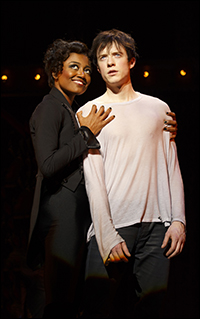
Three-time Tony nominee Paulus and her collaborator, Gypsy Snider of the Montreal-based circus company Les 7 doigts de la main, crafted this new, high-flying circus-inspired take on Roger O. Hirson and Stepehn Schwartz's dark and groovy coming-of-age musical Pippin, which earned ten 2013 Tony Award nominations, including Best Direction and Best Revival.
Playbill.com spoke with Paulus the day following Pippin's Tony nomination news:
It's clear from your work that you aren't content as an artist to stage a straightforward revival. There's always an invitation for audiences to re-explore something they think they know.
Diane Paulus: There's always something new. I'm always thinking about what will make the most powerful and visceral live moment in the present time that we are in for our audience. So when you're doing a revival, of course you're looking backwards at the history of the show and what made it great when it was first done, but I'm always trying to translate that to the moment we're living in today. How can I create anew that excitement when the show was originally done in its first incarnation?
Your production of Pippin is full of spectacle in a very human way. There's so much for audiences to take in. Were you ever concerned that the sensory experience would overwhelm the story? DP: All the time we were talking about the story – the arc. We made thousands of experiments with balls, juggling, flips and tricks, and whenever it felt like it was just a trick, it never worked. So, it was combing through all that vocabulary and saying, "Keep that! Keep that! That doesn't work there, move it here." It was about trying to feel the emotional power of Pippin and match the acrobatics and physical life to that.
Did you do a lot of table work with your actors in preparation?
DP: Tons of table work. Especially with Patina Miller and Matthew James Thomas. We asked, "What is this journey? Who is this Leading Player?" You don't get any clues in the script, it just says, "Leading Player." What is the history? What is driving her? Who is Pippin? How did he get sucked into this world? For every ensemble member on stage – why are they in this troupe? I had the actors doing exercises, create their back-stories, just to get everybody plugged into the stakes of what's going on on stage.
| |
 |
|
| Patina Miller and Matthew James Thomas in Pippin. | ||
| photo by Joan Marcus |
DP: In 1998, there was a production of Pippin where Theo came back [in the final moments] and Stephen saw it, I believe directed by Mitch Sebastian, and he said, "Oh my God, that's how Pippin should end!" So that ending has now been integrated into the script – that whole idea of the life cycle, of Theo repeating the ritual journey of what it means to find meaning and grow up, and have adventures, and experiences, and all the highs and lows. I think it's a beautiful new ending for Pippin – the idea that it's all going to happen again.
I understand lots of people in the cast have kids and that ending took on a literal meaning during rehearsals.
DP: Every time we had workshop presentations, or open rehearsals, all the people who had kids in the cast—we'd have all these kids in attendance—and as soon as we finished, all the kids would run, and start to climb the poles and jump on the balls. We all looked at each other and said, "That's it!" There's an impulse in our DNA to get on that tight wire, even though you know you might fall and hurt yourself, it's undeniable that human impulse to climb, and try, and have an adventure. So that reinforced the meaning of that ending.
Bob Fosse's mark on Pippin is indelible. In addition to his original staging, you can feel his point of view in the material itself. You chose to represent his work in the revival with the aid of his protegé Chet Walker. Some directors might resist using those ideas.
DP: I knew that the Fosse had to be part of this production. What Bob Fosse what did to Pippin is inextricably linked, especially for those people who remember seeing it — that collective unconscious memory. They wanna see those hips. They wanna see those hands. And then I met Chet Walker, who was introduced to me by Stephen Schwartz. He was in the original company, and worked very closely with Fosse, and he just encouraged me to open the production to the Fosse, but not be slavish about a museum replica. He said to me, "Bob Fosse never wanted to repeat himself. He really didn't like things to be video taped, he always wanted to start fresh." And, he apparently loved the circus and loved Federico Fellini. So this idea of taking the Fosse and mashing it up with circus, for me, somehow—I'm hoping that wherever Mr. Fosse is—he's smiling down on us for this, I hope, organic extension of his work.
(Adam Hetrick is the editor in chief of Playbill.com. His work appears in the news, feature and video sections of Playbill.com, as well as in the pages of Playbill magazine. Follow him on Twitter @PlaybillAdamH.)
Visit PippinTheMusical.com.
Watch Playbill Video's highlights from Pippin:










